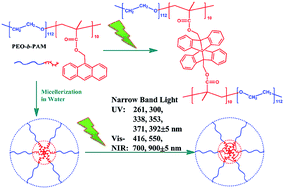The photodimerization characteristics of anthracene pendants within amphiphilic polymer micelles in aqueous solution†
Abstract
An amphiphilic polymer with anthracene pendants of PEO-b-PAM has been applied to comprehensively investigate the photodimerization characteristics of anthracene in aqueous solution upon various selected narrow band of light irradiations in the UV-vis-NIR region.


 Please wait while we load your content...
Please wait while we load your content...